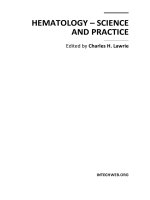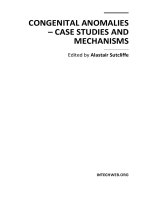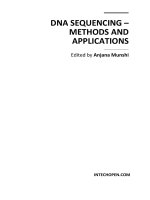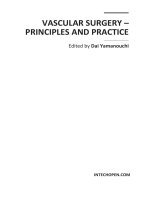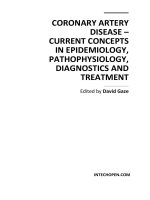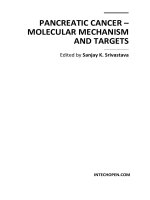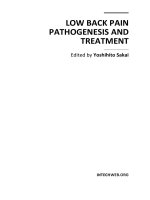Nanoscale Calibration Standards and Methods Edited by G. Wilkening, L. Koenders ppt
Bạn đang xem bản rút gọn của tài liệu. Xem và tải ngay bản đầy đủ của tài liệu tại đây (10.68 MB, 527 trang )
Nanoscale Calibration Standards
and Methods
Edited by
G. Wilkening, L. Koenders
Nanoscale Calibration Standards and Methods: Dimensional and Related Measurements in the Micro- and Nanometer Range.
Edited by Gunter Wilkening, Ludger Koenders Copyright
c
2005Wiley-VCHVerlagGmbH&Co.KGaA,Weinheim
ISBN:3-527-40502-X
Nanoscale Calibration
Standards and Methods
Dimensional and Related Measurements
in the Micro- and Nanometer Range
Edited by
Gçnter Wilkening, Ludger Koenders
Editors
Prof. Dr. Gçnter Wilkening
National Metrology Institute (PTB),
Nano- und Micrometrology Department
Dr. Ludger Koenders
National Metrology Institute (PTB),
Nano- und Micrometrology Department
Cover Picture
Illustration: Hans-Ulrich Danzebrink
All books published by Wiley-VCH are care-
fully produced. Nevertheless, authors, editors,
and publisher do not warrant the information
contained in these books, including this
book, to be free of errors. Readers are advised
to keep in mind that statements, data, illus-
trations, procedural details or other items
may inadvertently be inaccurate.
Library of Congress Card No.: Applied for
British Library Cataloguing-in-Publication Data:
A catalogue record for this book is available
from the British Library.
Bibliographic information published by
Die Deutsche Bibliothek
Die Deutsche Bibliothek lists this publication
in the Deutsche Nationalbibliografie;
detailed bibliographic data is available in the
Internet at < >.
c 2005 WILEY-VCH
Verlag GmbH & Co. KGaA, Weinheim
All rights reserved (including those of trans-
lation into other languages). No part of this
book may be reproduced in any form – by
photoprinting, microfilm, or any other means
– nor transmitted or translated into a
machine language without written permis-
sion from the publishers. Registered names,
trademarks, etc. used in this book, even when
not specifically marked as such, are not to be
considered unprotected by law.
Composition hagedorn kommunikation,
Viernheim
Printing Strauss GmbH, Mærlenbach
Bookbinding J. Schåffer GmbHiG,
Grçnstadt
Printed in the Federal Republic of Germany.
Printed on acid-free paper.
ISBN-13: 978-3-527-40502-2
ISBN-10: 3-527-40502-X
Contents
Part I Instrumentation – Overview
1 Metrological Scanning Probe Microscopes – Instruments for Dimensional
Nanometrology
3
Hans-Ulrich Danzebrink, Frank Pohlenz, Gaoliang Dai, and
Claudio Dal Savio
1.1
Introduction 3
1.2 High-Resolution Probing Systems 4
1.2.1 Sensor Objective with Beam Deflection Detection 5
1.2.2 Sensor Objective with Piezolever Module 7
1.2.3 Sensor Objective with Tuning Fork Module 8
1.2.4 Sensor Head for Combined Scanning Probe and Interference
Microscopy
9
1.3 Metrology Systems Based on Scanning Probe Microscopes 12
1.3.1 Scanning Force Microscopes of Type Veritekt 13
1.3.2 Metrological Large Range Scanning Force Microscope 15
1.4 Summary 18
Acknowledgments 19
References 19
2 Nanometrology at the IMGC 22
M. Bisi, E. Massa, A. Pasquini, G. B. Picotto, and M. Pisani
2.1
Introduction 22
2.2 Surface Metrology 23
2.2.1 Scanning Probe Microscopy 23
2.2.2 Optical Diffractometry 25
2.2.3 Stylus Profilometry 27
2.3 Atomic Scale Metrology 28
2.3.1 Lattice Parameter of Silicon 29
2.3.2 Combined Optical and X-Ray Interferometry (COXI) 30
2.4 Phase-Contrast Topograpy 31
2.4.1 Detection of Small Lattice Strain 31
2.4.2 Phase-Contrast Imaging 32
VContents
2.5 Nanobalance 34
2.6 Conclusions 35
References 36
3 Metrological Applications of X-ray Interferometry 38
Andrew Yacoot
3.1
Introduction 38
3.2 Measurement of Non-linearity in Optical Interferometers 40
3.3 Combined Optical and X-ray Interferometry 41
3.4 Measurement of Small Angles 42
3.5 X-ray Interferometry and Scanning Probe Microscopy 43
3.6 Conclusions 43
References 44
Part II Instrumentation – Long-range Scanning Probe Microscope
4 Advances in Traceable Nanometrology with the Nanopositioning and
Nanomeasuring Machine
47
Eberhard Manske, Rostislav Mastylo, Tino Hausotte, Norbert Hofmann,
and Gerd Jåger
4.1
Introduction 47
4.2 Design and Operation 48
4.3 Uncertainty Budget 52
4.4 Focus Sensor 53
4.5 Measuring Opportunities and Performance with Focus Sensor 55
4.6 Focus Probe with SFM Cantilever 58
4.7 Conclusion 58
Acknowledgements 59
References 59
5 Coordinate Measurements in Microsystems by Using AFM-Probing:
Problems and Solutions
60
Dorothee Hçser, Ralph Petersen, and Hendrik Rothe
5.1
Introduction 60
5.2 Realizing CMMs for Microsystems 61
5.3 Problems and Solutions 64
5.3.1 Dynamics of Positioning System 64
5.3.2 CMM: One-Millimeter Scan 67
5.3.3 Measuring Strategies 68
5.4 Conclusion and Outlook 71
References 72
VI Contents
6 Metrological Large Range Scanning Force Microscope Applicable for
Traceable Calibration of Surface Textures
73
Gaoliang Dai, Frank Pohlenz, Hans-Ulrich Danzebrink, Min Xu,
Klaus Hasche, Gçnter Wilkening
6.1
Introduction 74
6.2 Instrumentation 75
6.2.1 Principle 75
6.2.2 Metrological Properties 76
6.2.3 Traceability 78
6.2.4 Specially Designed Features 79
6.3 Measurement Result of a 2D-Grating Standard 80
6.3.1 Measurement Strategy 80
6.3.2 Data Evaluation 82
6.3.3 Measurement Result of the Mean Pitch Value 83
6.3.4 Measurement of the Local Pitch Variation 83
6.4 A Selected Measurement Result of a Microroughness Standard 85
6.4.1 Measurement Result of a Glass Flatness Standard 86
6.4.2 Measurement of a PTB Microroughness Standard 87
6.4.3 Comparison of the Roughness Measurement Results Derived from SFM
and Stylus Instruments Using Gaussian Filter
88
6.4.4 Comparison Using Morphological Filters 89
6.4.5 Evaluation Results Using PTB Reference Software 90
6.5 Outlook and Conclusion 91
References 92
Part III Instrumentation – Development of SPM and Sensors
7 Traceable Probing with an AFM
95
K. Dirscherl and K. R. Koops
7.1
Introduction 95
7.2 Setup 96
7.3 Correction for Piezo Nonlinearities 100
7.3.1 Hysteresis 100
7.3.2 Drift 102
7.4 Real-Time Control Through SSE2 Assembly 103
7.4 Implementation of the Measurement Controller 104
7.6 Image Analysis 105
7.7 Conclusions 107
Acknowledgments 108
References 108
8 Scanning Probe Microscope Setup with Interferometric Drift
Compensation
109
Andrzej Sikora, Dmitri V. Sokolov, and Hans U. Danzebrink
8.1
Motivation 109
VIIContents
8.2 Existing Setup – Without Drift Compensation 111
8.3 Measurement Method and Setup for Drift Compensation 112
8.4 Experiment and Results 115
8.5 Summary 118
References 118
9 DSP-Based Metrological Scanning Force Microscope
with Direct Interferometric Position Measurement and
Improved Measurement Speed
119
Gaoliang Dai, Frank Pohlenz, Hans-Ulrich Danzebrink, Klaus Hasche,
and Gçnter Wilkening
9.1
Introduction 119
9.2 Instrument 120
9.2.1 Principle 120
9.2.2 DSP-Based Signal Processing System 121
9.2.3 Calibration of the Tip Signal for Traceably Measuring the Bending
of the Cantilever
123
9.3 Correction of Nonlinearity of the Optical Interferometers
in the M-SFM
124
9.3.1 Review of Nonlinearity Correction Methods 124
9.3.2 Adapted Heydemann Correction in a Fast Servo Control Loop 125
9.3.3 Performance of the Interferometers in the M-SFM Veritekt C 126
9.4 Improving the Measurement Speed 128
9.5 A Measurement Example of Step-Height Standard 129
References 130
10 Combined Confocal and Scanning Probe Sensor for
Nano-Coordinate Metrology
131
Dmitri V. Sokolov, Dmitri V. Kazantsev, James W.G. Tyrrell, Tomasz Hasek,
and Hans U. Danzebrink
10.1
Introduction 132
10.2 Instrumentation and Experimental Details 133
10.3 Results and Discussion 136
10.3.1 Imaging in the Confocal and SPM Mode 136
10.3.2 One-Dimensional Optical and SPM Measurements 138
10.4 Summary and Conclusions 141
Acknowledgments 142
References 142
11 Combined Shear Force–Tunneling Microscope with Interferometric Tip
Oscillation Detection for Local Surface Investigation and Oxidation
144
Andrzej Sikora, Teodor Gotszalk, and Roman Szeloch
11.1
Introduction 144
11.2 Instrumentation 145
11.3 Local Surface Electrical Properties Investigation 152
VIII Contents
11.4 Local Surface Oxidation 152
11.5 Summary 154
Acknowledgements 155
References 155
12 Low Noise Piezoresistive Micro Force Sensor 157
L. Doering, E. Peiner, V. Nesterov, and U. Brand
12.1
Introduction 157
12.2 Manufacturing of the Sensor 158
12.2.1 Computer Aided Design 158
12.2.2 Manufacturing of the Sensor 158
12.3 Sensor Properties 160
12.3.1 Doping Profile 160
12.3.2 Spectroscopic Noise Analysis and Determination of the Hooge
Constant
163
12.3.3 Force Calibration and Electrical Calibration 165
12.4 Application: Force Calibration of a Stylus Instrument 167
12.5 Conclusions 169
References 170
Part IV Calibration – Overview
13 Towards a Guideline for SPM Calibration
173
T. Dziomba, L. Koenders, and G. Wilkening
13.1
Introduction 173
13.2 General 176
13.2.1 Schematic Description of SPMs 176
13.2.2 Metrological Classification of SPMs 177
13.2.3 Calibration Intervals 178
13.3 Verification of Properties of Instrument, Tip and Environment 178
13.3.1 Ambient Conditions 179
13.3.2 Flatness Measurements and Signal Noise 179
13.3.3 Repeatability and Noise 181
13.3.4 Tip Shape 182
13.4 Calibration of the Scanner Axes 183
13.4.1 Lateral Calibration 183
13.4.2 Calibration of the Vertical Axis 186
Using Laser Interferometers 187
Using Transfer Standards 188
Evaluation of Step Height 188
13.5 Uncertainty of Measurements 190
Acknowledgments 191
References 191
IXContents
14 True Three-Dimensional Calibration of Closed Loop Scanning Probe
Microscopes
193
J. Garnaes, A. Kçhle, L. Nielsen, and F. Borsetto
14.1
Introduction 193
14.2 Model of the Measurement System 194
14.3 The Correction Matrix 195
14.4 Theory for Estimating the Vertical Skew 196
14.5 Experimental Results and Discussion 200
14.6 Conclusion 202
Acknowledgements 202
Appendix 203
References 204
15 Height and Pitch at Nanoscale – How Traceable is Nanometrology? 205
L. Koenders and F. Meli
15.1
Introduction 205
15.2 Comparison on One-Dimensional Pitch Standards (NANO 4) 206
15.2.1 Standards and Measurand 206
15.2.2 Participants and Measurement Methods 207
15.2.3 Results 208
15.2.4 Uncertainty 210
15.2.5 Discussion 211
15.3 Comparison on Step Height (NANO4) 212
15.3.1 Standards 212
15.3.2 Measurement Methods 213
15.3.3 Results 214
15.3.4 Uncertainties 216
15.3.5 Discussion 217
15.4 Conclusions 218
Acknowledgment 218
References 219
16 The Behavior of Piezoelectric Actuators and the Effect on Step-Height
Measurement with Scanning Force Microscopes
220
A. Grant, L. McDonnell, and E. M. Gil Romero
16.1
Introduction 220
16.2 Experimental 222
16.2.1 Scanning Force Microscopes 222
16.2.2 Z Calibration with Step-Height Standards 223
16.2.3 Z Calibration with Fiber-Optic Displacement Sensor 223
16.3 Results 224
16.3.1 Effect of Voltage Sweep 224
16.3.2 Effect of Z Actuator Offset 225
16.3.3 Implications of Actuator Offset for Sample Tilt 227
16.3.4 Implications of Actuator Offset for Scanner Curvature 227
X Contents
16.4 Conclusions 228
Acknowledgments 228
References 228
17 An Approach to the Development of Tolerance Systems for
Micro- and Nanotechnology
230
J. Schæbel and E. Westkåmper
17.1
Introduction 230
17.2 Tolerancing and Standards 231
17.2.1 Measurement Systems Analysis 232
17.2.2 Step-Height Measurements 232
17.2.3 Microroughness 234
17.3 Machining Experiments 235
17.3.1 Micromilling 235
17.3.2 Sputtering 237
17.4 Conclusions 240
References 241
Part V Calibration – Standards for Nanometrology
18 Standards for the Calibration of Instruments
for Dimensional Nanometrology
245
L. Koenders, T. Dziomba, P. Thomsen-Schmidt, and G. Wilkening
18.1
Introduction 245
18.2 Standards for Scanning Probe Microscopy 246
18.2.1 Flatness Standard 246
18.2.2 Tip Characterizers 248
18.2.3 Lateral Standards 250
18.2.4 Step-Height Standards 252
18.2.5 Nanoroughness Standards 254
18.3 Film Thickness Standards 254
18.4 Outlook 256
Acknowledgments 256
References 257
19 “Atomic Flat” Silicon Surface for the Calibration of Stylus Instruments 259
S. Græger and M. Dietzsch
19.1
Calibration of Stylus Instruments 259
19.2 “Atomic Flat” Silicon as Calibration Standard 263
19.3 Selection of the Measurement Instrument for the Assessment of
Flatness
264
19.4 Calibration of the Stylus Instrument ME 10 265
19.5 Characteristics of the Measurement Instrument After Modification 267
19.6 Conclusions and Outlook 268
References 268
XIContents
20 Investigations of Nanoroughness Standards by Scanning Force Microscopes
and Interference Microscope
269
R. Krçger-Sehm, T. Dziomba, and G. Dai
20.1
Introduction 269
20.2 Standardization Aspects 270
20.3 Manufacturing of Calibration Specimens 271
20.3.1 Conditions for Smaller Roughness 271
20.3.2 Manufacturing Process 272
20.3.3 Profile Repetition 273
20.4 Measurements 274
20.4.1 Identification of the Fields of Interest 274
20.4.2 Correlation of Fields 274
20.4.3 Measurements with Interference Microscope 275
20.4.4 Scanning Force Microscope Measurements 276
20.4.5 Long Range SFM Measurements 278
20.4.6 Relation to Proven Roughness Standards 279
20.5 Conclusions and Outlook 279
Acknowledgments 281
References 281
21 Testing the Lateral Resolution in the Nanometre Range
with a New Type of Certified Reference Material
282
M. Senoner, Th. Wirth, W. Unger, W. Ústerle, I. Kaiander, R. L. Sellin,
and D. Bimberg
21.1
Introduction 282
21.2 Description of the Reference Material 283
21.3 Modeling of Lateral Resolution 284
21.3.1 Analysis of a Narrow Strip 288
21.3.2 Analysis of a Straight Edge 289
21.3.3 Analysis of Gratings 291
21.4 Conclusions 294
Acknowledgments 294
References 294
Part VI Calibration – Tip shape
22 Reconstruction and Geometric Assessment of AFM Tips
297
Torsten Machleidt, Ralf Kåstner, and Karl-Heinz Franke
22.1
Introduction 298
22.2 Reconstruction of the Tactile Tip 299
22.2.1 Imaging the Tip Using Scanning Electron Microscopy 299
22.2.2 Reconstruction by Known Sample Structure 300
22.2.3 Blind Tip Estimation 301
22.2.4 Motivation 301
22.2.5 Tip Assessment 302
XII Contents
22.2.5.1 Two-Dimensional Characterization 302
22.2.5.2 Geometrical Interpretation 303
22.2.5.3 Tip Angle 304
22.2.5.4 Tip Radius 305
22.2.5.5 Tip Curvation 305
22.2.5.6 Review 306
22.2.6 Three-Dimensional Characterization 306
22.2.6.1 Geometrical Interpretation 306
22.2.6.2 Simulated Annealing Algorithm 307
22.2.6.3 Convergence 308
22.2.7 Experimental Results 309
22.3 Summary and Outlook 309
References 310
23 Comparison of Different Methods of SFM Tip Shape Determination for
Various Characterisation Structures and Types of Tip
311
S. Czerkas, T. Dziomba, and H. Bosse
23.1
Introduction 311
23.2 Instrumentation 312
23.3 Results and Discussion 313
23.3.1 Needs of CD Metrology 313
23.3.2 Tip Shape Determination 314
23.3.3 Conclusions 318
23.4 Summary 320
References 320
Part VII Calibration – Optical Methods
24 Double Tilt Imaging Method for Measuring Aperture Correction Factor
323
Yen-Liang Chen, Chao-Jung Chen, and Gwo-Sheng Peng
24.1
Introduction 323
24.2 Traceability of Step Height 324
24.3 Working Principle of DIT method 325
24.4 Experimental Setup 326
24.5 Relative Standard Uncertainty of Numerical Aperture Correction
Factor
328
24.6 Uncertainty Analysis of the Numerical Aperture Correction Factor 329
24.7 Conclusion 329
References 330
25 How Statistical Noise Limits the Accuracy of Optical Interferometry
for Nanometrology
331
Victor Nascov
25.1
Introduction 331
25.2 Optical Interferometry Overview 332
XIIIContents
25.2.1 Two Waves Interferometry 332
25.2.2 Multiple Waves Interferometry 337
25.3 Statistical Errors on Processing Elementary Fringe Patterns 337
25.4 Wavelengths and Displacements Measurement 340
25.5 Absolute Distance Measurement 341
25.6 Conclusions 343
References 344
26 Uncertainty Analysis of the PTB Measuring Equipment for the Investigation
of Laser Interferometers
345
G. Sparrer and A. Abou-Zeid
26.1
Introduction 345
26.2 The Calibration Facility 346
26.3 Measurement Procedure 348
26.4 The Uncertainty of the Complete Calibration Facility 349
26.4.1 The Measurement Uncertainty of the Comparator 349
26.4.2 The Measurement Uncertainty of the Standard Laser Interferometer
Taking Into Account the Refractive Index of Air and the Thermal
Expansion
352
26.4.3 The Expanded Measurement Uncertainty of the Entire Calibration
Facility
355
Signs and Symbols of the Model Equations and the Uncertainty
Budgets:
356
References 357
Part VIII Application – Lateral Structures
27 Lateral and Vertical Diameter Measurements on Polymer Particles with a
Metrology AFM
361
F. Meli
27.1
Introduction 361
27.2 Experimental Setup 363
27.3 Measurement Results and Discussion 365
27.3.1 Height Measure ments on Gold Colloids 365
27.3.2 Possible Systematic Deviations with Height Measurements on Gold
Colloids
368
27.3.3 Lateral Measurements on Polymer Spheres 370
27.4 Conclusion 374
References 374
28 Pitch and CD Measurements at Anisotropically Etched Si Structures in an
SEM
375
C. G. Frase, S. Czerkas, H. Bosse, Yu. A. Novikov, and A. V. Rakov
28.1
Introduction 376
28.2 GWPS Specimen 376
XIV Contents
28.3 SEM Instrumentation 377
28.4 SEM image formation and Modeling 377
28.5 SEM Measurement Method 381
28.6 Measurement Results 382
28.7 Conclusion 384
References 384
29 Analysis and Comparison of CD-SEM Edge Operators: A Contribution to
Feature Width Metrology
385
C.G. Frase, W. Håßler-Grohne, E. Buhr, K. Hahm, and H. Bosse
29.1
Introduction 385
29.2 Exponential Fit Operator 387
29.2.1 Secondary Electron Image Formation at Structural Edges 387
29.2.2 Definition of Top CD Operator 390
29.2.3 SEM Model Input Parameter Variations 390
29.2.4 Experimental Parameter Variations 392
29.2.5 Measurement Results 393
29.3 Modified Exponential Fit Operator for High Sidewall Angles 394
29.4 Gauss Fit Operator 396
29.5 Signal Decay Operator 398
29.6 Conclusion 402
References 403
30 Measurement of High-Resolution Interferential Encoders Using the PTB
Nanometer Comparator
404
J. Flçgge, R. Koening, and H. Bosse
30.1
Principle 404
30.2 Laser Interferometer 405
30.3 Incremental Linear Encoders 406
30.4 Measurement Results 408
References 409
Part IX Application – Surface
31 Experimental Characterization of Micromilled Surfaces by Large-Range
AFM
413
P. Bariani, G. Bissacco, H. N. Hansen, and L. De Chiffre
31.1
Introduction 413
31.2 Micromilling of Hardened Tool Steel 414
31.3 Surface Topography Measurement 415
31.4 Large-Range Atomic Force Microscopy 416
31.5 Techniques Used for Comparison 416
31.6 Evaluation of Sampling Conditions for the Different Techniques 417
31.7 Results 418
31.8 Discussion and Conclusions 422
XVContents
References 423
32 Investigation of the Surface Roughness Measurement
of Mass Standards
424
C. Zerrouki, L.R Pendrill J. M. Bennett, Y. Haidar, F. de Fornel, and P. Pinot
32.1
Introduction 424
32.2 Requirements for Surface Roughness of Mass Standards 425
32.3 Surface Roughness Measurement Methods Applied to Mass Stan-
dards
426
32.3.1 Mechanical Profiler (NAWC-US) 427
32.3.2 Near Field Microscope (LPUB, FR) 427
32.3.3 Angle-Resolved Light Scattering (BNM-INM, FR) 428
32.3.4 Angle-Resolved Light Scattering (Lasercheck, US) 428
32.3.5 Total Integrated Light Scattering (SP, SE) 429
32.4 Results and Instruments Comparison 429
32.5 Conclusion 432
References 433
33 Surface Analysis of Precision Weights for the Study of Commonly Occurring
Contaminants
434
Ulf Jacobsson and Peter Sjævall
33.1
Introduction 434
33.2 Experimental 435
33.3 Results 438
33.4 Discussion and Conclusions 442
References 442
34 Tip-Shape Effect on the Accuracy of Capacitance Determination by Scanning
Capacitance Microscopes
443
SStefan Lnyi
34.1
Introduction 443
34.2 Probe geometry 445
34.3 Simulated topographic Artifacts 446
34.4 Results 447
34.5 Discussion 450
References 451
35 Atomic Force Microscope Tip Influence on the Fractal and Multi-Fractal
Analyses of the Properties of Randomly Rough Surfaces
452
P. Klapetek, I. OhlÌdal, and J. BÌlek
35.1
Introduction 452
35.2 Data Simulation and Processing 453
35.3 Fractal Properties Analysis 454
35.4 Multi-Fractal Properties Analysis 457
35.5 Results and Discussion 460
XVI Contents
35.6 Conclusion 461
References 462
Part X Application – Material Properties
36 Atomic Force Microscope Indentation Measurement Software
465
David Shuman
36.1
Introduction 465
36.2 Experimental Details 468
36.2.1 Sample Preparation 469
36.2.2 Indentation Procedure 469
36.2.3 AFM Calibration 469
36.2.4 Surface Height and Roughness 470
36.2.5 Projected Area 470
36.2.6 Projected Area 473
36.2.7 Surface Area 473
36.2.8 Elastic Reconstruction 474
36.2.9 Building the Area Functions 475
36.2.10 Indenter Angle and Radius 476
36.2.11 NanoMc Hardness 477
36.3 Conclusion 479
Acknowledgments 479
References 480
37 Nanodeformation Analysis Near Small Cracks by Means of NanoDAC
Technique
481
Jçrgen Keller, Dietmar Vogel, and Bernd Michel
37.1
Introduction 481
37.2 Digital Image Correlation on SPM Images 482
37.2.1 Principle of NanoDAC 482
37.2.2 Stability Aspects of SPM Measurements 484
37.3 Crack Evaluation 488
37.3.1 Experimental Setup 488
37.3.2 Crack Opening Displacement Analysis 489
37.4 Adaptation to Finite Element Analysis 491
37.4.1 Adaptation Concept 491
37.4.2 Mesh Transfer from FEA to Experiment 493
37.4.3 Verification Platform 494
Derotation and Displacement Matching 494
Determination of Material Properties 495
37.5 Application of DIC to Micromachined Gas Sensor 496
37.6 Conclusions 498
Acknowledgments 498
References 498
XVIIContents
38 PTB’s Precision Interferometer for High Accuracy Characterization of Thermal
Expansion Properties of Low Expansion Materials
500
R. Schædel and A. Abou-Zeid
38.1
Introduction 500
38.2 Experimental Setup 503
38.2.1 Description of the Interferometer 503
38.2.2 Sample Design 504
13.2.3 Autocollimation Adjustment 506
13.3 Check Measurements 507
38.4 Measurement Examples 508
38.4.1 Thermal Expansion and Uncertainty 509
38.4.2 CTE Homogeneity 511
38.4.3 Temporal Length Changes 512
38.5 Concluding Remark 514
References 514
Index 515
XVIII Contents
List of Contributors
XIXList of Contributors
Chapter 1
H U. Danzebrink, F. Pohlenz, G. Dai,
and C. Dal Savio
National Metrology Institute (PTB),
Braunschweig, Germany
Chapter 2
M. Bisi, E. Massa, A. Pasquini,
G. B. Picotto, and M. Pisani
CNR – Institute of Metrology
“G. Colonnetti”, Torino, Italy
Chapter 3
A. Yacoot
National Physical Laboratory,
Teddington, Middlesex, UK
Chapter 4
E. Manske, R. Mastylo, T. Hausotte,
N. Hofmann, and G. Jåger
Technical University Ilmenau,
Institute of Process- and Sensor
Engineering, Ilmenau, Germany
Chapter 5
D. Hçser, R. Petersen, and H. Rothe
Measurement and Information
Technology, University of the Federal
Armed Forces, Hamburg, Germany
Chapter 6
G. Dai, F. Pohlenz, H U. Danzebrink,
M. Xu, K. Hasche, and G. Wilkening
Physikalisch-Technische Bundesanstalt
(PTB), Braunschweig, Germany
Chapter 7
K. Dirscherl
1
and K. R. Koops
2
1
National Metrology Institute (PTB),
Braunschweig, Germany
2
Nederlands Meetinstituut, Van
Swinden Laboratorium (NMi-VSL),
Delft, The Netherlands
Chapter 8
A. Sikora, D. V. Sokolov, and
H. U. Danzebrink
National Metrology Institute (PTB),
Braunschweig, Germany
Chapter 9
G. Dai, F. Pohlenz, H U. Danzebrink,
K. Hasche, and G. Wilkening
National Metrology Institute (PTB),
Braunschweig, Germany
XX List of Contributors
Chapter 10
D. V. Sokolov, D. V. Kazantsev,
J. W.G. Tyrrell, T. Hasek, and H U.
Danzebrink
National Metrology Institute (PTB),
Braunschweig, Germany
Chapter 11
A. Sikora, T. Gotszalk, and R. Szeloch
Faculty of Microsystems Electronics
and Photonics, Wroclaw University
of Technology, Poland
Chapter 12
L. Doering
1
, E. Peiner
2
, V. Nesterov
1
,
and U. Brand
1
1
National Metrology Institute (PTB),
Braunschweig, Germany;
2
Institute for Semiconductor
Technology, Technical University of
Braunschweig, Germany
Chapter 13
T. Dziomba, L. Koenders, and
G. Wilkening
National Metrology Institute (PTB),
Braunschweig/Berlin, Germany
,
Chapter 14
J. Garnaes, A. Kçhle, L. Nielsen, and
F. Borsetto
Danish Institute of Fundamental
Metrology, Lyngby, Denmark
Chapter 15
L. Koenders
1
and F. Meli
2
1
National Metrology Institute (PTB),
Braunschweig und Berlin, Germany
2
Swiss Federal Office of Metrology and
Accreditation (METAS),
Bern, Switzerland
Chapter 16
A. Grant, L. McDonnell, and
E. M. Gil Romero
Centre for Surface & Interface Analysis,
Department of Applied Physics &
Instrumentation, Cork Institute of
Technology, Ireland
Chapter 17
J. Schæbel and E. Westkåmper
Institute of Industrial Manufacturing
and Management, University of
Stuttgart, Germany
Chapter 18
L. Koenders, T. Dziomba, P. Thomsen-
Schmidt, and G. Wilkening
National Metrology Institute (PTB),
Berlin/Braunschweig, Germany
Chapter 19
S. Græger and M. Dietzsch
Institute of Production Measuring
Technology and Quality Assurance,
Chemnitz, Germany
XXIList of Contributors
Chapter 20
R. Krçger-Sehm, T. Dziomba, and
G. Dai
National Metrology Institute (PTB),
Braunschweig, Germany
Chapter 21
M. Senoner
1
, Th. Wirth
1
, W. Unger
1
,
W. Ústerle
1
, I. Kaiander
2
, R. L. Sellin
2
,
and D. Bimberg
2
1
Federal Institute for Materials Research
and Testing (BAM), Berlin, Germany
2
Institut fçr Festkærperphysik, Tech-
nische Universitåt Berlin, Germany
Chapter 22
T. Machleidt, R. Kåstner, and
K H. Franke
Computer Graphics Program, Technical
University of Ilmenau, Germany
Chapter 23
S. Czerkas, T. Dziomba, and H. Bosse
National Metrology Institute (PTB),
Braunschweig, Germany
Chapter 24
Y L. Chen, C J. Chen, and G S. Peng
Center for Measurement Standards/
ITRI, Taiwan, Republic of China
Chapter 25
V. Nascov
National Institute for Laser, Plasma
and Radiation Physics,
Bukarest, Romania
Chapter 26
G. Sparrer and A. Abou-Zeid
National Metrology Institute (PTB),
Braunschweig, Germany
Chapter 27
F. Meli
Swiss Federal Office of Metrology and
Accreditation (METAS),
Bern, Switzerland
Chapter 28
C. G. Frase
*
, S. Czerkas, H. Bosse
Physikalisch-Technische Bundesanstalt
(PTB), Braunschweig, Germany.
Carl.
Chapter 29
C. G. Frase, W. Håßler-Grohne, E. Buhr,
K. Hahm, and H. Bosse
National Metrology Institute (PTB),
Braunschweig, Germany
Carl.
Chapter 30
J. Flçgge
National Metrology Institute (PTB),
Braunschweig, Germany
Chapter 31
P. Bariani, G. Bissacco, H. N. Hansen,
and L. De Chiffre
Department of Manufacturing, Engi-
neering and Management, Technical
University, Lyngby, Denmark
XXII List of Contributors
Chapter 32
C. Zerrouki
1
, L.R Pendrill
2
J. M. Bennett
3
, Y. Haidar
4
,F.de
Fornel
4
, and P. Pinot
1
1
BNM-INM/Cnam, 292, Paris, France
2
Swedish National Testing and
Research Institute, Boras, Sweden
3
Naval Air Warfare Center,
China Lake, USA
4
Equipe Optique de Champ Proche
LPUB, Dijon, France
Chapter 33
U. Jacobsson
1
and P. Sjævall
2
1
Measurement Technology,
2
Chemistry and Materials Technology,
SP Swedish National Testing and
Research Institute, Boras, Sweden
Chapter 34
SSt. Lnyi
Slovak Academy of Science, Institute
of Physics, Bratislava, Slovakia
Chapter 35
P. Klapetek
1
, I. OhlÌdal
2
and J. BÌlek
1,2
1
Czech Metrology Institute, Brno,
Czech Republic
2
Department of Physical Electronics,
Faculty of Science, Masaryk University,
Brno, Czech Republic
Chapter 36
D. Shuman
NanoMc Company, New York, USA
Chapter 37
J. Keller, D. Vogel, and B. Michel
Fraunhofer Institute for Reliability and
Microintegration (IZM), Dept.
Mechanical Reliability and Micro
Materials, Berlin, Germany
Chapter 38
R. Schædel and A. Abou-Zeid
National Metrology Institute (PTB),
Braunschweig, Germany
Part I
Instrumentation – Overview
Nanoscale Calibration Standards and Methods: Dimensional and Related Measurements in the Micro- and Nanometer Range.
Edited by Gunter Wilkening, Ludger Koenders Copyright
c
2005Wiley-VCHVerlagGmbH&Co.KGaA,Weinheim
ISBN:3-527-40502-X
1
Metrological Scanning Probe Microscopes –
Instruments for Dimensional Nanometrology
Hans-Ulrich Danzebrink, Frank Pohlenz, Gaoliang Dai, and Claudio Dal Savio
Abstract
An overview of PTB’s activities in the field of dimensional nanometrology using
scanning probe microscopes (SPMs) is presented. The chapter is divided into two
parts: the development of (1) high-resolution probing systems and (2) complete
SPM metrology systems. The subject of SPM-probing system design comprises,
among other things, the concept of the “sensor objective” to combine conven-
tional microscopy with scanning probe techniques. In the field of complete me-
trological SPM systems, the measuring properties of one of the existing SPM
metrology systems have been significantly improved by including laser inter-
ferometers directly into the position control loop and by a clear reduction of
the nonlinearity of the interference signals. In addition, the application spectrum
of metrological SPM has been considerably extended by the establishment of an
SPM system with a measuring volume of 25 mm q 25 mm q 5 mm.
1.1
Introduction
In many fields of material sciences, biology, and medicine, conventional scanning
probe microscopes (SPMs) serve to visualize small structures with dimensions
down to atoms and molecules as well as to characterize object-specific properties
(magnetism, friction, thermal conductivity, and the like). For a large part of the
investigations, the image information obtained with the SPM is completely suffi-
cient for the qualitative investigation of the sample. Because of their high spatial
resolution, use of these microscopes is also of great interest for metrological ap-
plications. This is why the PTB has begun using SPMs in dimensional metrology
as one of the first national metrology institutes [1, 2].
A fundamental requirement for precise length measurements is, however, the
addition of a length measuring system to the microscope scanning system. For
this purpose, the piezo actuators that serve for positioning and scanning of sam-
31.1 Introduction
Nanoscale Calibration Standards and Methods: Dimensional and Related Measurements in the Micro- and Nanometer Range.
Edited by Gunter Wilkening, Ludger Koenders Copyright
c
2005Wiley-VCHVerlagGmbH&Co.KGaA,Weinheim
ISBN:3-527-40502-X
ple or measuring head, are in many cases position-controlled via additional sen-
sors (strain gauges, capacitive or inductive sensors) by which disadvantages of
piezo elements, such as hysteresis or creeping, are compensated [3–10]. The
use of these additional sensor systems does not release the user from performing
regular calibrations. In the majority of cases, the SPM is calibrated with the aid
of special standards with microstructures of defined geometry. Detailed infor-
mation on such calibration standards can be found in another article of this edi-
tion [11]. The disadvantage of discrete calibration via standards is, however, that
linearization of the positioning measuring systems is based on a few reference
points only which are given by the material measure. This leads to higher calibra-
tion effort when objects of different height or structure periods are to be mea-
sured.
This is why users with high demands on the uncertainty of SPM measure-
ments have in the past few years proceeded to equip the individual axes of the
positioning system with laser interferometers. This allows the positioning values
to be continuously traced back to the wavelength of the laser light and thus to the
SI unit “meter”. The fundamental idea is to treat the SPM like a miniaturized
three-coordinate measuring machine and to correct its metrological properties
with the device’s control software.
As in the case of coordinate measuring machines, the SPM measuring systems
can be divided into probing system and positioning unit. The structure of the
present chapter reflects this aspect. The first part describes the PTB activities
in the development of high-resolution probing systems based on scanning
probe microscope techniques. The second part deals with precise positioning
units and with the complete SPM measuring and calibration devices that are
available at PTB.
1.2
High-Resolution Probing Systems
PTB’s development of probing systems based on SPMs is aimed at constructing
and optimizing these measuring heads for use in dimensional nanometrology.
Needless to say that the sensor systems described cannot only be used for metro-
logical applications, but are of general interest for scanning probe microscopy and
coordinate measuring techniques.
The scanning force microscopes (SFMs) are those of the family of SPMs that
are of special importance for dimensional metrology. This is mainly due to the
fact that their use is not limited to conductive surfaces as it is, for example, the
case for scanning tunnel microscopes. The design principle of an SFM is
shown in Figure 1.1. In this case, the deflection detection system of the cantilever
moving relative to the surface is based on an optical beam deflection principle,
thus keeping the cantilever with the integrated measuring tip in a constant dis-
tance to the surface. The sample is then investigated line by line, and the profiles
are subsequently composed in a computer to form an image.
4 1 Metrological Scanning Probe Microscopes – Instruments for Dimensional Nanometrology
In addition to the properties important from the viewpoint of metrology such as
stability, sensitivity, and noise behavior, different other aspects have been incorpo-
rated into PTB’s device development:
x
Combination of the SPM measuring heads with optical micro-
scopes: here, the optical function extends from visualization to
quantitative dimensional or analytical methods.
x
The use of different detection principles: the movement and
position of the measuring tip is measured by an external optical
procedure or via an intrinsic electrical measuring principle.
x
The use of different measuring tip materials: in recent develop-
ments, special diamond tips are used in addition to silicon and
silicon nitride tips.
1.2.1
Sensor Objective with Beam Deflection Detection
As the name already suggests, the concept of the so-called sensor objective
directly takes up the combination of microscope objective and sensor, the sensor
in this case working as a scanning probe microscope. The special feature of this
sensor head development is that existing optical standard microscopes are used as
a basis: because of the compact geometry and the special design, the sensor ob-
jective (composed of SPM module and imaging optics) can be directly screwed
into the turret of an optical microscope [12]. This allows two microscopy worlds
to be ideally combined.
In measuring operation, the advantages of the combined system become ob-
vious. Firstly, the well-proven conventional light microscopy is used for fast and
extensive surface investigation. The spectrum of tasks extends from the orienta-
tion on the measurement object to quantitative optical measurements (see Sec-
tion 1.2.4). Then local measurement is performed with the slower serial scanning
probe procedure in the measurement area defined for calibration or, generally, at
those points of the sample which require a high resolution.
51.2 High-Resolution Probing Systems
Fig. 1.1 Sketch of a scanning
force microscope (SFM) with
cantilever probe and beam
deflection detection.



